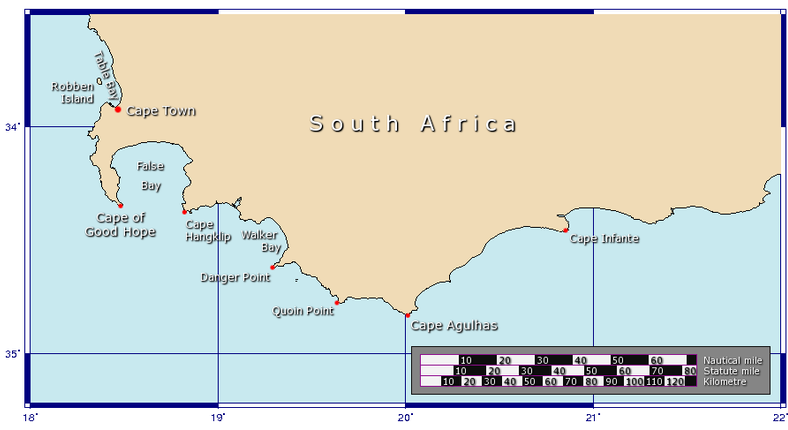When Portuguese explorer Bartolomeu Dias rounded the rocky headland of South Africa’s Cape Peninsula in 1488, he became the first European to do so, thus opening the way for a sea route from Europe to Asia. He named it the “Cape of Storms”, because of the perilous sea, but it was later renamed “Cape of Good Hope”, because it brought hopes of a new sea route to India. On his return journey, Dias passed another rocky headland, but he was unaware that this unimpressive point was the southern extremity of Africa. Indeed, many people still believe that Cape of Good Hope is the southern-most tip of the African continent, but that title belongs to Cape Agulhas – the inconspicuous rocky headland about 150 km further south. Incidentally, Cape Agulhas is also the place where the official dividing line between the Atlantic and Indian Oceans passes. A stone plaque on the beach marks the place.
The boundary was not arbitrarily chosen. This is the place where the warm-water Agulhas current of the Indian Ocean meets the cold water Benguela current of the Atlantic Ocean and turns back on itself. However, any physical definition of a meeting point or dividing line between two oceans ignores the fact that currents don’t just halt their flow at any point. Ocean currents shift and mingle.
Where the Indian and Atlantic oceans actually meet has been the topic of many heated arguments among South Africans. To root of the confusion is that the point at which the Agulhas current meets the Benguela current tends to fluctuate seasonally between Cape Agulhas and Cape Point, about 1.2 kilometers east of the Cape of Good Hope. According to marine biologists, the actual meeting point can be established by observing the differences in marine life brought about by the changes in temperature along the coast. For instance, the prolific kelp (Ecklonia maxima) forests, which prefer colder water, grows all the way from the West Coast, past Cape Point in an easterly direction, only as far as Cape Agulhas. This fact supports the argument that the dividing line between the warm and cold waters is more often at Cape Agulhas than anywhere else.

However, to the chagrin of Cape Agulhas’ residents, it’s Cape Point that draws more tourists than Cape Agulhas, who come to witness the Indian and Atlantic oceans splashing together. Businesses in Cape Point are cashing in on the misinformed tourists. Gift shops in the area sell souvenirs like coffee mugs, T-shirts, collector spoons and bottles of ocean water - all emblazoned with the slogan, "Cape Point, South Africa: Where Two Oceans Meet."
A part of the reason why Cape Agulhas fails to draw many tourists than they should is because it isn’t quite as spectacular or dramatic as Cape Point. “To stand at Cape Point is an experience like stepping to the edge of the Grand Canyon,” writes John Murphy in Baltimore Sun. “There is almost too much for the eye to take in. Visitors tend to pause before reaching for their cameras, in awe of all that is before them: the dramatic cliffs, the sea looking as if it's coming to a boil below, the seabirds riding the wind, in the distance the southern right whales peeking above the waves.”
Quick fact: Cape Agulhas was named by Portuguese navigators, who called it Cabo das Agulhas — Portuguese for "Cape of Needles" —because they noticed that the compass needle, hence the direction of magnetic north, coincided with true north in that area. The Earth’s magnetic north pole, however, shift slowly with time, thus changing magnetic declination values throughout the world accordingly. The declination around the cape today is some 25°W, which means that the magnetic north pole lies 25 degrees to the left of true north.
The lighthouse at Cape Agulhas. Photo credit
The cliffs of Cape Point. Photo credit
Sources: Wikipedia / www.vincentmounier.com / Capeinfo / SAHistory / Teatime Mag


















I am thrilled to find this post clarifying where the actual southern-most tip of Africa is and agree that it isn't as dramatic as Cape Point BUT I have always found that standing at Cape Agulhas and looking out to sea, knowing that I am right on the very tip of our magnificent continent with one ocean on my left and one on my right mind boggling. I do also think that the drive to L'Agulhas across the Agulhas Plain and the coastline as dramatic as Cape Point. #justsaying
ReplyDelete